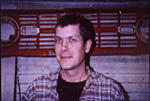February 2000 field recordings by scout |
|||||||||||||||||||||||||||||||||
|
Is it difficult, when someone wants to buy a painting? Is it hard for you to let it go? I mean, aside from the fact that you kind of realize, "All right! I can pay the rent this month!"
SB: Yeah, it's really more rent-oriented. Which is not to make it sound like a totally commercial endeavor, but it is a form of validation when people buy [work]. And then, usually they buy it because they really like it. I mean, I'm not a household name, so there's no investment issues in the way. A lot of art does not necessarily go up in value. Very little art goes up in value, actually. So
Thank god you've got the rock band to fall back on!
SB: Mmm, great. I've got 2 money-sucking operations.
If only you could moonlight as a philosopher.
SB: That's right. Sometimes I miss things, or I regret selling pieces because they were the ones thatyou know, when you have a set of pieces, you'll have your favorites andyou'll know which ones are the best ones. The other ones are good, but they're maybe not your favorites. It's not that they're not necessarily your best work, but they failed somehow in your mind, and you moved on for a variety of reasons, rather then beat them to death. And the pieces that are really good, oftentimes other people will somehow sense that you like them and buy them.
Really?
SB: Unless you take steps in advance and say, "Well, I don't want to sell this one." Or you don't let it out of the studio at all. A lot of times it means not even showing it to anybody, since as soon as you do, they're going to want to buy it, or the dealer's going to want to talk you out of it. Money is a bit motivator too, you know. Because it is about the rent.
Yeah. It's a weird kind of catch-22 career to be in. You make these things because you have something that you want to do, some need to create, and then you either have to give it up so that you can do more
SB: Well, there are people making work that can't be sold. And that's a noble operation, definitely. I mean, I have always liked objects, and objects are always meant to be sold in a way.
Do you ever work with found objects? More tangible, three-dimensional art?
SB: I used to use found objects a lot. I have a whole body of work thatthis piece is mine. (Points to a strange, bowling pin shaped item sitting on the edge of the table.) That's just a doo-dad.
What made you decide not to do this kind of work anymore?
SB: My whole [problem] with sculpture was that it started to back up on me in an unpleasant manner. Suddenly I just had a whole lot of extra pieces that weren't gonna show and weren't gonna sell and [that I] didn't want to storeI threw away a lot of stuff. I switched to drawing after about '93, I guess. I was starting to work more at the museum, and I just had less time to make art, and I needed to be able to—not finish an idea in one sitting or anything but at least be able to
Stick it behind the couch when you weren't working on it?
SB: At least be able to see progress. Before that I did fairly process-oriented things. I'd make the sculpture, you know, assemble it out of found objects, and then I'd take photographs of it, and I would make a canvas. The canvas would be a printed photograph of the object, and these would be diptychs that would go together. Those were labor-intensive. I did it for like 3 or 4 years, that kind of stuff. And I just have not been able to find that much energy to do those kinds of pieces. Art has a tendency to take the form of what you're willing to do.
The path of least resistance?
SB: Well, I don't mean that, but if you have 15 minutes to make art, it's going to look like art you made in 15 minutes. And if you're willing to spend 6 months on a piece, it will look like you spent six months on it. It does not necessarily mean it will be better, it just means it can be more complicated, it can be more elaborate. And I don't intend to spend that long on each idea. I wanted something more immediate that I could get out and get in and see results and move on. And so the graphic work has been nice that way.
Let's talk about the actual subject matter of the work that you're doing. In the majority of things that I've seen, you focus on words. What's that all about?
SB: There was a point in art history, very contemporary art history, maybe late 1980s or even the early '90s, in which word art was very popular, very trendy. I never thought I could do that for some reason. I never really liked it, and I never thought of it as something I would pursue. And here I am doing it. A couple of events sort of lead me to itI'm reticent to say what those are. But they needed direct expression, those kinds of things. And when I started to [put] down the things that I was feeling, it just came out as words. I liked the way they looked and I liked the way the writing was kind of a calligraphic sort of mark that could be abstract and it could [still have] meaning. It had a visual kind of a resonance too.
I liked the pieces with blank faces, images with no meaning to them, and yet the background bursting with lists of names
SB: Those were the kind of depersonalized sort of silhouette that[represented] the Everyman. [I did] lots of them with names. I mean, I started off with just name-calling, and kind of infantile name-calling, the more infantile the better. I reserve the right to return to that at any moment.
So you find strength in the words as concepts, as words with meanings, as opposed to simply combinations of shapes, of letterforms?
SB: Yeah. I'm definitely more oriented toward the meanings of the words. I mean, thethe last series was sort of set off by the Columbine shooting stuff. And, I know it's probably not very obvious from the – or maybe it is – from the paintings themselves but the choice of words came from that kind of thing. And they were mostly verbs, action verbs. Transitive verbs, as they say
Your work is in series, then? First names, and now verbs?
SB: [I] kind of moved out from [names] to titles. Like "king of the hill" or "top of the heap" kind of stuff. [I was] just kind of hunting and gathering those kind of expressions in the language. When I hear a phrase, I'm often set off on that kind of association. I categorize things. The silhouette series came earlier, before the more recent things, like the crayon and the bottle and the dice, things like that.
Do you ever get criticism from people that see, for instance, a painting that has only a grid full of words? Do people say, "What the hell is that? That's just a bunch of damned words."
SB: I had a scroll in the show, it was a 23 foot scroll, just four letter verbs, just little blocks, all on a continuous piece of paper running from the ceiling down to the floor, and people really liked that piece. A lot of people said that was the best piece in the show. Umnobody pulled out their checkbook for it, but still It actually is a pretty stunning piece, if I do say so myself.
You're allowed.
SB: I've had plenty of criticism over my [style]. Plenty of "Oh, my kid could do that," or "What's so special about that?" And you know, that's probably the least informed kind of criticism that anybody can level at your art. You learn not to really take it very seriously: "Yeah, but your kid is not going to make this." Or more coarsely, "Okay, well, let's see 'em." You know, that kind of thing. I've got plenty of responses to that. It doesn't take anything into account, it just dismisses automatically. I've dismissed work in my time. But you've got to give somebody credit for just getting his shit together to actually get it onto the paper.
Well, that's what I was going to say, it feels like a lot of people, when they criticize, I almost think that it's a bitterness that they didn't do it first: "I could have done that," but inside they're thinking, "Damn, why didn't I think of that?"
SB: Well, maybe. But not on a conscious level. I can't imagine most of them are very jealous of being an artist. They just don't want it to seem too easy.
Artists have to be tortured.
SB: Sometimes when it looks easy, it really gets their goat. People resent art and I don't really know why. I don't know why there's that kind of lowbrow resentment and highbrow arrogance that seems to be in our culture.
I'm pretty bitter that I didn't think of that. (Points to a large metal basket on the floor in the corner, filled with old metal crank handles.)
SB: That's mine as well. It's not really a finished piece, in a way.
Is that just a basket of cranks? Or is itare they fastened down? I mean, is that set in place?
SB: No, they're just [piled in] there. The meat-grinder handles. For a while I went down to the As-Is shop down in East Oakland and I would take the meat-grinder handles from all the meat-grinders. (laughs) It's not full. It's close, but But that was going to be part of something else, and I didn't ever finish the piece. Lynn likes that thing, so we keep it, but it weighs a ton. Like all art: weighs a ton.
All good art.
SB: (Sighs.) All good art just weighs heavily.
in the junk drawer:
|
|
















